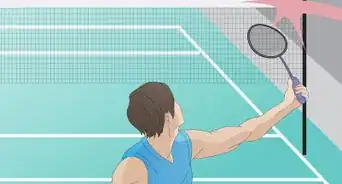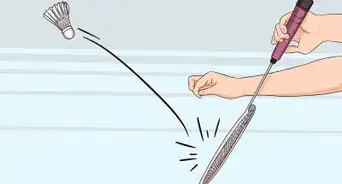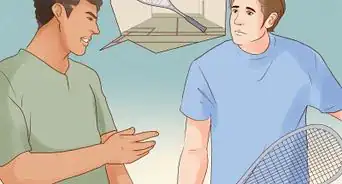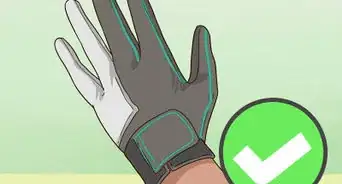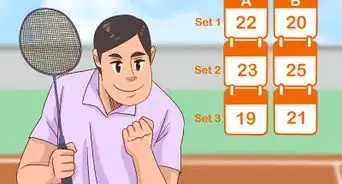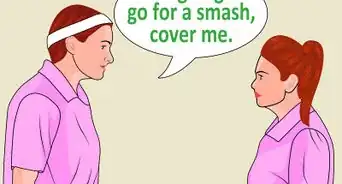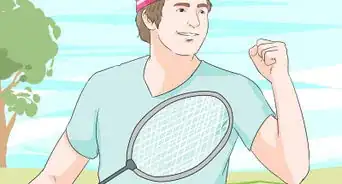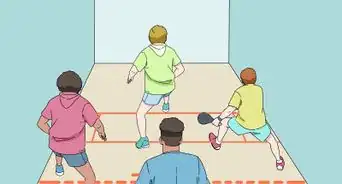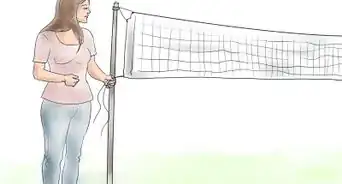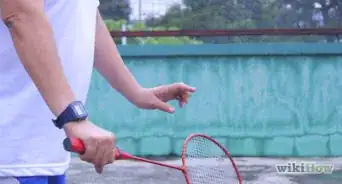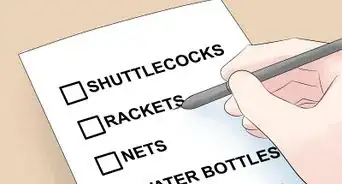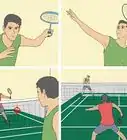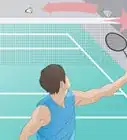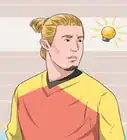X
wikiHow is a “wiki,” similar to Wikipedia, which means that many of our articles are co-written by multiple authors. To create this article, volunteer authors worked to edit and improve it over time.
Learn more...
Padel is a fast-paced game that combines elements of tennis, squash, and beach tennis. It's an extremely popular racket sport because it's easy to learn and fun to play! It's a great way to spend time with your family and friends. It is usually played in doubles, but it can also be played in singles.
Steps
Part 1
Part 1 of 4:
Getting Started
-
1Find a place to play. Padel courts are 20x10 meters, so about 30% smaller than a tennis court. Each side of the net is a 10-meter square.
- The courts have 3-meter walls and metal fencing around their sides, with an additional meter of fencing at the top of the back part of the wall. Walls were traditionally made out of cement, but are usually made out of glass today.
- The court's flooring is generally sandy synthetic turf. The lines are drawn to indicate the service boxes.
- The net should be 92 centimeters at the posts and 88 centimeters in the center, so about 15cm shorter than a tennis net.
- The ceiling must be at least 6 meters throughout the court.
-
2Get geared up. You don't need to purchase professional tennis gear from the first match, most padel clubs will rent you a padel racket and balls, so all that you need to bring are athletic clothes and shoes.
- Padel rackets are made with foam cores and carbon fiber or fiberglass surfaces. Adult rackets weigh roughly 365 grams. Padel balls are like tennis balls, but with less pressure. Clay court tennis shoes are best for padel courts' sandy surfaces, but if you don't have them, any pair of sneakers will do.
Advertisement -
3Find a match. Once you have the gear and the basics down, ask your local club to help you arrange a match or put you into a messaging group for arranging matches.
Advertisement
Part 2
Part 2 of 4:
Learn the Basics
-
1Learn about the parts of the padel court. The padel court is divided into two sides by the net - your side and your opponent's side.
- Similar to tennis, the service boxes are the boxes made by the white lines on the court, your serves need to land on the cross-court side to be in. Your partner will cover the forehand (right) or backhand side, and you will cover the other.
- You must hit the ball into the opponent's side of the court in order for your shot to count as in. The ball must hit the ground before hitting the glass fence or wall, in order to be in. During regular gameplay, the ball may deflect off the net and still land on the ground of your opponent's side and still be in, but if it hits the fence or the wall first, it is out (there is an exception to this rule in serves).
- If your opponent is not able to hit the ball back over to your side before it bounces a second time, you win the point.
- You can "boast" the ball off your glass wall, and if it lands on their side of the court, it is in.
- If the ball bounces very close to the wall, you can tell whether it was in or out based on the sound and by the angle at which it bounces back. If it bounces back from the back wall at a lower angle than what it came in with and with some topspin, then that usually means it hit the back wall first and is out. Of course, if it is very close, and trying to play the ball to keep it in play in order to demonstrate good sportsmanship.
-
2Learn the basics of padel scoring. Padel scoring is the same as tennis. Most matches are played by winning the best of three sets. Sets are won with six games. Tiebreaks settle six-six sets. Games are played with the same tennis scoring: 15-30-40.
- Because padel has long rallies, the matches can get long. Some padel players looking for faster matches, play with the "Golden Point" rule of one point winning 40-40 games, but most follow tennis and require winning the game by winning two points in a row.
-
3Hold the racket correctly. Most padel players hold the racket with the "continental" grip, which is basically the natural way of holding a hammer. This grip will allow you to have the same grip for serves, forehands and backhands.
-
4Practice padel serves. Similar to tennis, padel serves must be made from behind the service line on your side of the court across the court diagonally to your opponent's service box. Contrary to tennis, padel serves are made from below the waist, and the ball must be bounced on the ground prior to contact.
- The ball must go over the net and land its first bounce in the service box to be in. It can hit the side or back wall after bouncing off the ground, but it can not hit the side fence or it is out. Similar to tennis, the server has double faults, so if the first serve is out, they can make a more conservative second serve to start the point.
- Like tennis, if the serve hits the net and bounces in, the server has a "let" and can take an additional serve. If the ball hit the net and bounces outside of the service box or in the service box and then into the fence, then the serve is out. Servers change sides every game, and alternate partners each time.
- Volleying a return of serve is not allowed.
- Like tennis and unlike squash, when the ball lands on the line, it is in.
-
5Practice your forehand. At the back of the court, padel strokes are smaller and involve the wrist less than tennis strokes. You should step with your opposite-side leg as you stroke the ball.
-
6Practice your backhand. Most padel players' backhands are one-handed, but they start the movement with the non-dominant hand pinching the bridge of the racket before expanding out with both of their arms from their back.
-
7Practice padel volleys. Padel volleys are basically the same as tennis, they should be aimed for the service line, so that your opponent doesn't know whether to hit them before or after they bounce off the back wall.
-
8Practice padel lobs. Lobs are very important in padel as they are the key to controlling the net, which is the key to controlling the game. Lobs should be made with the racket parallel to the ground and by lifting the ball up with your legs, core, and shoulder as much as your arm. The lob should be aimed to go well over the heads of your opponents and land in the back quarter of the court.
-
9Practice padel overheads. As lobs are so important, you will also hit more overheads in padel than you will in tennis. Therefore there are many types of overheads with different goals, however, the most common overhead is the bandeja, or "tray" in Spanish, which is so named because of the flat way that the racket is held when contacting the ball. Players use the bandeja, not to win the point like tennis overheads are used, but to regain the net and keep their opponents back. The bandeja is hit like a forehand volley at three o'clock.
Advertisement
Part 3
Part 3 of 4:
Playing a Match
-
1Determine the server. Either play a first point or flip a coin to determine the server. The one who doesn't win normally chooses the side and will serve the second game.
-
2Position yourself correctly. Most padel players use the "Australian formation". Here, partners stick to their preferred side, which results in the server and their partner starting the point on the same side for half of the points. The server's partner will be at the net, and after the server serves from behind the baseline, they will run up to join their partner at the net.
-
3Use proper etiquette. Padel is a very social game and should be played with kindness, so do not hesitate to play a "let" or a redo if the ball was hard to clearly see as in or out. It is also recommended that the server call out the score - their score first - in order to reduce confusing conversations about the score.
Advertisement
References
About This Article
Advertisement

